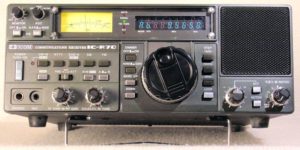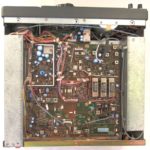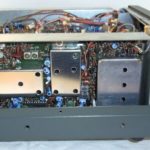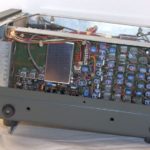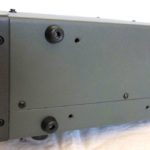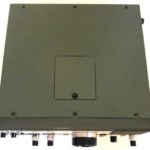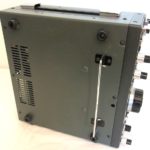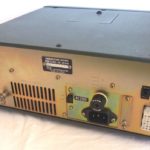The Icom IC-R70 receiver was produced during 1982 to 1984 in Japan. The receiver system is a quadruple conversion superheterodyne covering 0.1 MHz to 30 MHz with 100 Hz display resolution. The frequency stability is better than 250 Hz after 1 minute to 60 minutes, and better than 50 Hz after 60 minutes at usual indoor ham temperature. Advanced features include: Pass Band Tuning, IF notch, adjustable AGC, three tuning rates, dual VFOs, Scope Jack, Line Output, RIT, dial lock, converter input jack, adjustable noise blanker and built-in preamplifier.
ICOM IC-R70 Basic Specifications:
Quadruple conversion superheterodyne (AM/SSB/CW/RTTY)
1st IF: 70.45 MHz
2nd IF: 9.01 MHz
3rd IF: 455 kHz
4th IF: 9.01 MHz
Triple conversion superheterodyne (FM, optional)
1st IF: 70.45 MHz
2nd IF: 9.01 MHz
3rd IF: 455 kHz
Frequency Range: 0.1-30 MHz, in 30 bands, 1 MHz wide each.
Operating Voltage: Mains 117/235 V AC 30VA
Size: (W*H*D): 286*111*276 mm / 11.25 × 4.37 × 10.87 inches
Weight: 7.4 kg / 16.3 lbs
Sensitivity: AM (10 dB S+N/N) 0.1-1.6 MHz: 3 uV, 1.6-30 MHz: 0.5 uV
SSB/CW/RTTY (10 dB S+N/N) 0.1-1.6 MHz: 1 uV, 1.6-30 MHz: 0.15 uV
(Optinal: FM (12 dB SINAD) 1.6-30 MHz: 0.3 uV)
Selectivity: AM: 6 KHz (-6 dB), 18 kHz (-60 dB)
SSB/CW/RTTY: 2.3 KHz (-6 dB), 4.2 kHz (-60 dB)
CW-N/RTTY-N: 500 Hz (-6 dB), 1.5 kHz (-60 dB)2, 4 and 8 KHz
(Optional: FM: 15 KHz (-6 dB), 25 kHz (-60 dB))
Antenna impedance: 50 Ohms SO-239 or single wire on 0.1-1.5 MHz
Audio output: 8 Ohms, 2 Watts
The only thing I had to do after cleaning this receiver, was to replace the bulb for the S-meter. It was easily replaced with a LED and protective resistor since it was driven by the internal 13.8 VDC.
Tuning is made within 1 MHz segments, but this is easy to handle with the Up/Down switches.
I found the receiver to be surprisingly sensitive, I could hear a lot of stations out there when testing it on my EWE-antenna. This item has not the optional FM-unit (EX-257) installed, even if the pushbutton for FM is there on the front. One thing that’s a positive quality on this model of receiver, is that it does not require a backup-battery like modern receivers with microprocessors. So there are no memories, but no trouble with RAM backup failure that can make some modern receivers completely inoperative.
Now this receiver is sold (february 2017) to a skilled radioamateur living in the rural areas of Örnsköldsvik (ca 90 km north of Härnösand).
References:
http://www.rigpix.com/icom/icr70.htm
